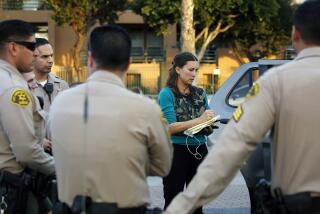Bradley Orders Probe of SIS Police Unit
Mayor Tom Bradley on Tuesday ordered the Los Angeles Police Commission to investigate the Police Department’s little-known Special Investigations Section, which follows career criminals but often ignores opportunities to prevent them from committing violent crimes.
Bradley, who spent 22 years in the Police Department, said he did not know that the unit existed until he read about it in The Times.
“I doubt that the (Police) Commission is even aware of this special unit,” Bradley said. “The things which were disclosed, I think, were startling. We have to have some firm policies so that innocent people are truly protected and that we do not unduly expose them to the possibilities of injuries or death.”
Bradley said he has asked the commission to “set some policies” that would more closely govern surveillances of criminal suspects.
“I’ve asked the Police Commission to investigate the entire operation (of SIS), take appropriate action and report to me on their findings,” Bradley said. “In setting policies, I’ve also asked them to take a look not only at the worth of the unit, but the size of it and all of the aspects (of) such a high level of undercover operation.”
The Times on Sunday reported that the 19-man SIS shadows armed robbers and burglars, among other criminal suspects, but often does not attempt to prevent them from victimizing shopkeepers and homeowners. The Times’ investigation documented numerous instances in which well-armed teams of SIS detectives stood by watching as innocent victims were traumatized emotionally and, in some instances, physically harmed by armed criminals who could have been arrested beforehand on lesser charges.
Police officials explained that SIS detectives sometimes wait to watch armed robberies and burglaries because the criminals can then be irrefutably linked to the crimes and often tied to other, unsolved crimes, leading to a longer prison sentence.
23 Fatally Shot
The Times found that surveillances in which SIS detectives watched criminals commit burglaries or robberies have often ended with the criminals being killed or wounded. In all, SIS detectives have shot 46 people, 23 of them fatally, over the last 23 years.
At the Police Commission’s regular Tuesday meeting, acting President Stephen D. Yslas said the article will prompt a commission inquiry into SIS practices.
“We will be examining these issues and turning to the chief for his expert opinion at a future time,” Yslas said.
Taking a similarly neutral position was Commissioner Reva B. Tooley.
“If something needs to be corrected, we will,” she said. “At the same time, if nothing needs correcting, we will point that out at the proper time.”
Police Chief Daryl F. Gates said in a brief interview after the commission meeting that he views the article as an example of the newspaper’s “bias” against the Police Department.
“Our Medal of Valor winners got an inch in the paper. This gets three pages,” he said. “If that doesn’t expose The Times, I don’t know what does.”
Gates said he particularly objected to any characterization of SIS as a secret unit within the Police Department.
Unit Not ‘Secret’
“There’s been nothing secret about it,” he said. “Certainly we haven’t broadcast it to the felon community, although we now have The Times to thank for doing that.
“It has accomplished a great deal,” Gates added. “Every major department has a similar unit. When you suggest we deliberately put people in danger, that is nonsense.”
The Times surveyed the nation’s largest police departments, more than 20 in all, and found that none had a full-time surveillance squad. Officers in other cities were critical of SIS tactics.
Gates, however, said the SIS merits praise rather than criticism.
“It’s a dirty, hard, tough, dangerous job,” he said. “I notice the article didn’t say anything about grateful parents of children who have been kidnaped and rescued safely because of the bravery of SIS officers. We should be praising them instead of criticizing them.
Asked for details of kidnapings resolved by the SIS, Gates said, “There aren’t that many kidnapings.”
An LAPD spokesman, Lt. Fred Nixon, later cited two situations in recent years in which SIS detectives have rescued kidnaped children.
One of them occurred in April, 1985. Records show that SIS detectives tried to tail a man believed to have kidnaped a 4-year-old girl, Deanna Jin, from her home in Van Nuys. A high-speed chase ensued, ending on a residential street in North Hollywood where the driver, Erez Bar-Levav, 24, crashed his car.
When Bar-Levav tried to back up his car and, according to police reports, attempted to run over two SIS members, both opened fire. He was shot eight times in the back, back of the head, face, chest and both legs.
Detectives pulled his body from the car and found papers leading to his address. There they located the kidnaped girl, who was unharmed.
The second incident cited by Nixon involved the safe return of a 14-month-old Pacific Palisades girl kidnaped near her home and held for $20,000 ransom in March, 1987.
The girl, Jacqueline Elizabeth Newmark, was found safe in an Encino park, while a dozen LAPD officers armed with shotguns were seizing kidnap suspect Mark Faulkner at a ransom pickup spot a few miles away.
The child’s father, Harris Newmark, said at the time that he and his wife were extremely grateful to the Police Department.
“They deserve a lot of credit,” Newmark said.
Gates, in his remarks Tuesday, also said that it “borders on the outrageous” that The Times identified SIS members and the number of shootings in which each had been involved.
“Their children are exposed to possible ridicule and their wives have to go through it all over again,” the chief said.
Meanwhile, in a related action Tuesday, City Councilwoman Gloria Molina introduced a special motion directing that Gates report in closed session to the council to explain SIS “missions and objectives.”
“I didn’t realize we had such a special unit,” Molina said. “I’m certainly concerned about how innocent victims are involved in this issue (and that) we may be endangering the lives of people.”
More to Read
Sign up for Essential California
The most important California stories and recommendations in your inbox every morning.
You may occasionally receive promotional content from the Los Angeles Times.










